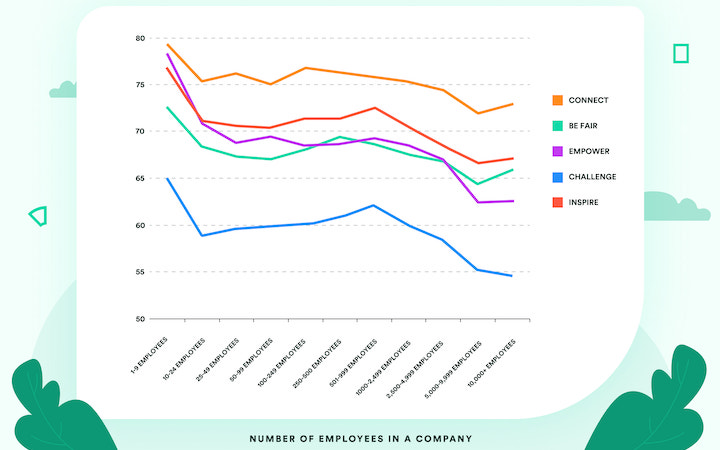
Could you be happier at work?
Take our quiz and find out! It takes just five minutes and you'll get a data-packed report afterwards.
How the Size of an Organization Can Make Employees Unhappy
If your organization is recovering from a setback, take time to envision what it will look like. Our challenge to you is not to just simply rebuild, but to make your organization structure something better than it was before.

After four months of pandemic conditions, you’ve hopefully still got a business. In fact, since our post about the curve of resiliency, we’re now seeing companies emerge from the initial setback of Covid-19 and bouncing back. Hopefully, you’ve done the same. If not, hang in there, keep working on it – the bounce back will come!
Now is the time to think about what your recovery looks like. This year, many companies were forced to toss their structures aside in favour of working from home. We’re only now starting to pick up the pieces. Now, the question on many leaders’ minds is “How do we put it together again?”
At Friday Pulse, we’re here to help you answer that question. And our answer is a challenge: Redefine the way you work. Make your organization better than before.
To survive upcoming uncertainty, we need increased creativity and flexibility from all levels of our organizations. And creativity comes from happy people. But, when looking at all the possible ways to rebuild an organization, an often-overlooked factor is size. Yet, our data has shown that organization size has a direct impact on employee happiness.
Organizational size and happiness

Our data is based on a pool of 22,000 people and shows that larger organizations have less happy people. The chart above is free from the influence of income and job roles, so we see that the happiest organizations are the smaller ones, with people that are inspired about a cause.
The reasons why large organizations are unhappy are many. The size can be dehumanising. People may feel unrecognised and unappreciated. Hierarchy limits variety, so the size of organizations means that not everyone knows each other.
The Five Ways to Happiness at Work and Organizational Size

The Five Ways to Happiness at Work are the drivers of positive culture and happiness within the workplace. They are: Connect, Be Fair, Empower, Challenge and Inspire. Each of these factors has a direct impact on the happiness levels within a company. Interestingly enough, The Five Ways to Happiness at Work are impacted by organization size too.
In the graph above, Empower — sharing responsibility which can unleash innovation and collaboration — shows the most dramatic drop from being the second-highest to the second-lowest scoring metric. The sharp drop makes sense because autonomy gets lost within larger organizations. Employees don’t usually get to shape what happens within large companies.
What the data boils down to is this: your company may have an inherent flaw in its structure due to its size, which prevents employees from being truly happy with their experience of work.
How to improve your organizational structure
You can’t cut up a large organization without serious problems, but how do you change your organizational structure to be happier?
In a sense, the task is creating a village in a city — a group with tight connections — to mitigate the problems of size. Remember, people’s work experience is proximal. Appreciation from your teammates and how you get along with your boss affects you more than what you think of the CEO.
Here are our recommendations on how you can improve your organization’s structure.
Empower your people
Because empowerment is something large organizations struggle with, give your people more control. Large organizations tend to have more tightly defined roles and outputs. As a result, people don’t get to shape, impact or influence their roles.
As a team leader, it’s your job to make roles more interesting for your people. The easiest way to do this is to play to their strengths. Identify the strengths of your team and match them to the areas where people can add the most value.
Break the silo and hierarchy
With so many organizations now remote, one of the biggest threats is that everyone will get siloed in some way. Typically, innovation in a hierarchy has to go up and down the structure, leading to siloed teams.
In teams made up of members across functions, teams can work on problems not only in their function but gain insight from other departments as well. Hierarchies should make way for a structure that functions as a network of teams rather than the traditional organizational chart.
With fewer middle managers, there are more people to do the work and make crucial decisions. The added space also means that teams are not only more creative in coming up with solutions, but they’re happier as well.
Learn from other innovative organizations
Over the past few months, many companies have completely redefined the way they do business. Some aren’t returning to traditional office structures, and some are implementing four-day work weeks to mitigate burnout. What works for your organization is something only you can determine, but here are a few that stood out to us:
- McKinsey shared a great piece on different organizations who have pivoted with speed during the pandemic.
- Zappos has adopted a system that’s a hybrid between their much praised holocracy and self-organization — a marketplace system where teams operate like small business and manage their own profit and loss statements. It’s a fascinating way to drive success.
- If there is a place that is synonymous with hierarchy, it’s the military. That’s what makes AFWERX unique. They are a community of US Air Force innovators that use academic and non-traditional contributors to bring innovation to the Air Force. Recently, our Founder and CEO, Nic Marks was keynote speaker at AFWERX Fusion virtual event.
How we can help
The strength of Friday Pulse is that it can penetrate at a team level and help teams and senior leaders understand what’s taking place across their organizations, on both a micro and macro level. By tracking positive and negative emotions, and systematically collecting feedback, it provides real-time insights on individuals, teams and organizations as we continue to adapt to a new reality.
To find out more, please contact our Head of Helping People, George Hargreaves george@fridaypulse.com.